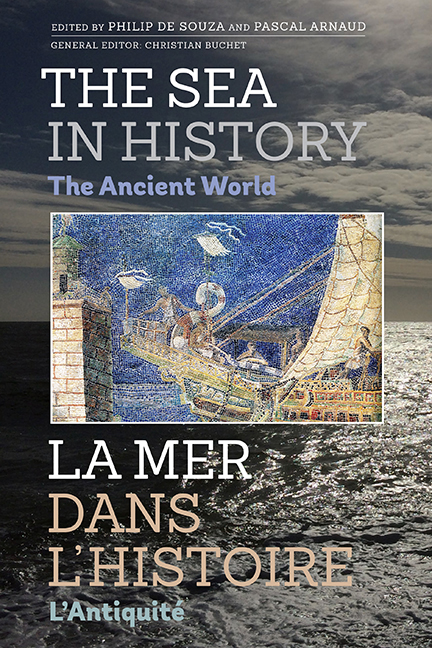Book contents
- Frontmatter
- Contents
- List of Illustrations
- List of Contributors
- Introduction générale et remerciements par Christian Buchet
- General introduction and acknowledgements
- Introduction (français)
- Introduction (English)
- La mer est le propre d'Homo sapiens
- PREHISTORICAL CASE STUDIES
- HISTORIAL CASE STUDIES: The Ancient Near East and Pharaonic Egypt
- HISTORICAL CASE STUDIES: The Mediterranean world
- Mediterranean ship technology in Antiquity
- Greek colonization, connectivity, and the Middle Sea
- Les infrastructures portuaires antiques
- Alexandria and the sea in Hellenistic and Roman times
- The development of Roman maritime trade after the Second Punic war
- La mer et l'approvisionnement de la ville de Rome
- The Roman Empire and the seas
- Les techniques de pêche dans l'Antiquité
- The consumption of salted fish in the Roman Empire
- Taxing the sea
- Les détroits méditerranéens dans la construction de l'image de la mer Intérieure dans l'Antiquité
- Ancient sea routes in the Black Sea
- Maritime risk and ritual responses: sailing with the gods in the Ancient Mediterranean
- La mer, vecteur d'expansion du christianisme au Ier siècle
- Maritime military practices in the pre-Phoenician Levant
- La naissance des flottes en Egée
- The Athenian maritime empire of the fifth century BC
- Financial, human, material and economic resources required to build and operate navies in the classical Greek world
- Les expéditions athéniennes en Sicile, ou la difficulté pour une marine de garder sa supériorité
- Pourquoi Alexandre le Grand a-t-il choisi de licencier sa flotte à Milet?
- Hellenistic and Roman republican naval warfare technology
- La marine de guerre romaine de 284 à 363
- Rome and the Vandals
- HISTORICAL CASE STUDIES: The Indian Ocean and the Far East
- Conclusion (français)
- Conclusion (English)
- Conclusion générale par Christian Buchet
- General conclusion
- Comprendre le rôle de la mer dans L'histoire pour éclairer notre avenir
- Understanding the role the sea has played in our past in order to shed light on our future!
La marine de guerre romaine de 284 à 363
from HISTORICAL CASE STUDIES: The Mediterranean world
Published online by Cambridge University Press: 20 April 2017
- Frontmatter
- Contents
- List of Illustrations
- List of Contributors
- Introduction générale et remerciements par Christian Buchet
- General introduction and acknowledgements
- Introduction (français)
- Introduction (English)
- La mer est le propre d'Homo sapiens
- PREHISTORICAL CASE STUDIES
- HISTORIAL CASE STUDIES: The Ancient Near East and Pharaonic Egypt
- HISTORICAL CASE STUDIES: The Mediterranean world
- Mediterranean ship technology in Antiquity
- Greek colonization, connectivity, and the Middle Sea
- Les infrastructures portuaires antiques
- Alexandria and the sea in Hellenistic and Roman times
- The development of Roman maritime trade after the Second Punic war
- La mer et l'approvisionnement de la ville de Rome
- The Roman Empire and the seas
- Les techniques de pêche dans l'Antiquité
- The consumption of salted fish in the Roman Empire
- Taxing the sea
- Les détroits méditerranéens dans la construction de l'image de la mer Intérieure dans l'Antiquité
- Ancient sea routes in the Black Sea
- Maritime risk and ritual responses: sailing with the gods in the Ancient Mediterranean
- La mer, vecteur d'expansion du christianisme au Ier siècle
- Maritime military practices in the pre-Phoenician Levant
- La naissance des flottes en Egée
- The Athenian maritime empire of the fifth century BC
- Financial, human, material and economic resources required to build and operate navies in the classical Greek world
- Les expéditions athéniennes en Sicile, ou la difficulté pour une marine de garder sa supériorité
- Pourquoi Alexandre le Grand a-t-il choisi de licencier sa flotte à Milet?
- Hellenistic and Roman republican naval warfare technology
- La marine de guerre romaine de 284 à 363
- Rome and the Vandals
- HISTORICAL CASE STUDIES: The Indian Ocean and the Far East
- Conclusion (français)
- Conclusion (English)
- Conclusion générale par Christian Buchet
- General conclusion
- Comprendre le rôle de la mer dans L'histoire pour éclairer notre avenir
- Understanding the role the sea has played in our past in order to shed light on our future!
Summary
RÉSUMÉ.Cette contribution étudie la flotte militaire de l'empire romain tardif en s'intéressant à ses bâtiments, à son personnel et à ses missions. Elle explique le déclin relatif de la puissance navale romaine au IIIe siècle ap. J.-C. et la renaissance qui a suivi au début du IVe siècle, jusqu'à la disparition finale de la flotte permanente dans la deuxième moitié de ce siècle.
ABSTRACT.This contribution analyses the naval fleets of the late Roman Empire, discussing ships, personnel and missions. It explains the relative decline of Roman naval power in the 3rd century AD and the subsequent revival in the early 4th century, as well as the eventual disappearance of standing fleets in the latter half of that century.
Les historiens ont longtemps pensé que la période de L'histoire romaine qui est communément appelée Bas-Empire a été marquée par un profond déclin. Mais, au milieu du XXe siècle, des archéologues ont contesté ce schéma et défendu une autre thèse : certes, le IIIe siècle a connu une crise profonde ; mais une renaissance est attestée à partir du début du IVe siècle. Nous avons nuancé ce jugement : le redressement a été plus vigoureux en Orient et un nouveau déclin a caractérisé l'Occident après le milieu du IVe siècle.
Dans ces conditions, la première question qui se pose, quand on entreprend une enquête sur la marine militaire romaine du Bas-Empire, est de savoir si elle a même existé. En effet, quelques auteurs nient une résurgence. D'autres observent un silence qui le ferait penser. D'autres enfin en parlent, souvent peu et rarement beaucoup.
- Type
- Chapter
- Information
- The Sea in History - The Ancient World , pp. 484 - 495Publisher: Boydell & BrewerPrint publication year: 2017

